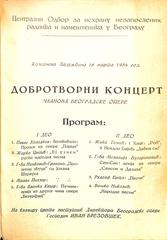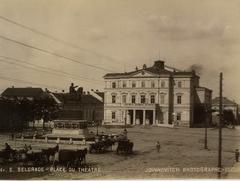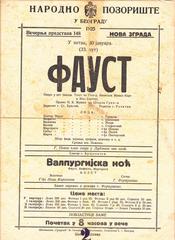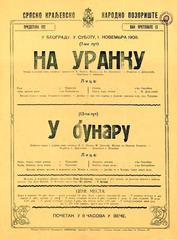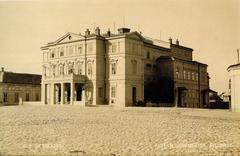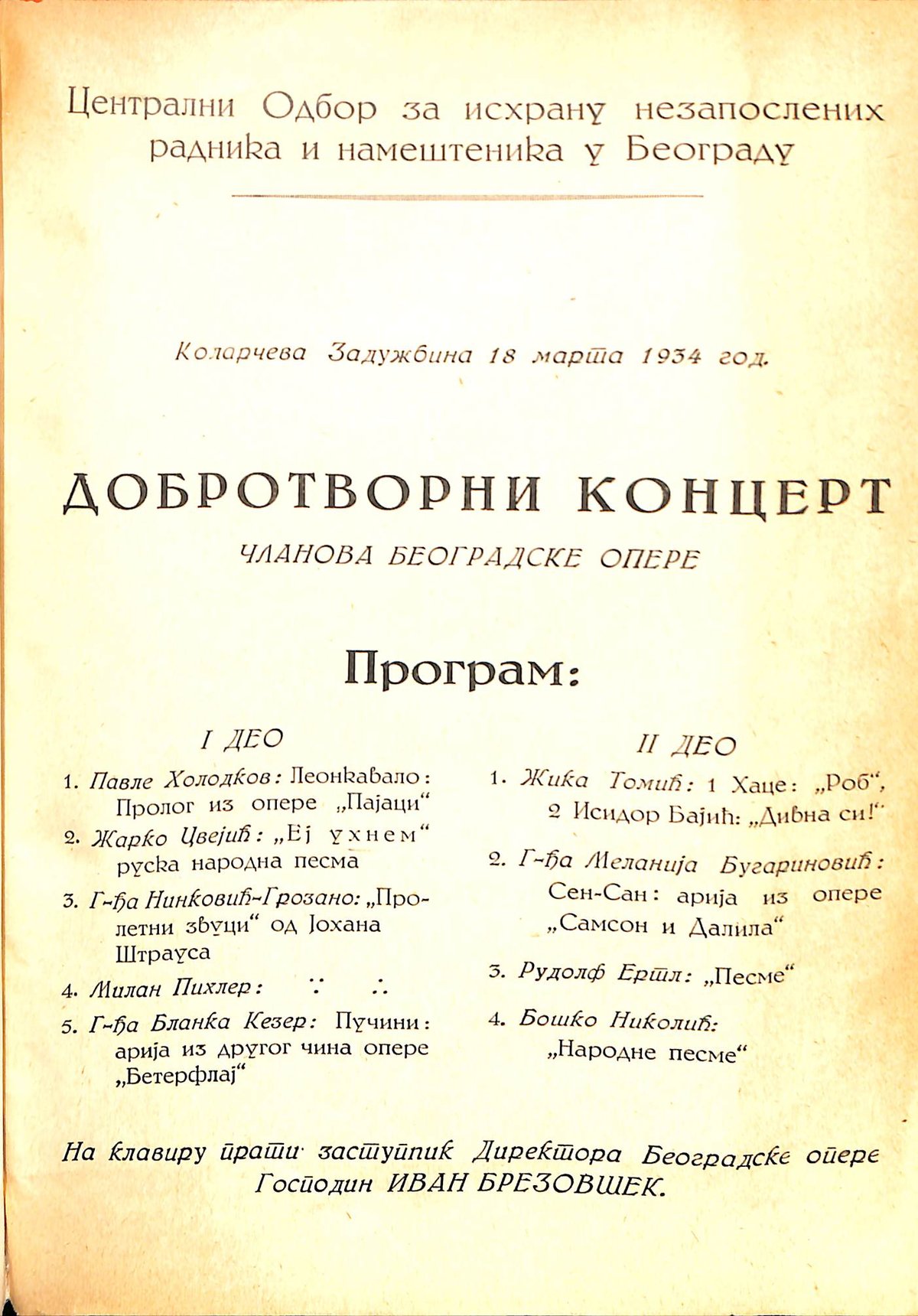
National Theatre Belgrade: Visiting Hours, Tickets, and Visitor Guide
Date: 14/06/2025
Introduction: A Pillar of Serbian Culture and History
The National Theatre in Belgrade, situated at the heart of Republic Square, is not just a premier venue for performing arts—opera, ballet, and drama—but also a monument chronicling the evolution of Serbia’s national identity. Since its founding in 1869, the theatre has played a central role in shaping the country’s cultural landscape, surviving wars, urban transformations, and political upheavals while continuously fostering artistic innovation and excellence (beotura.rs; belgrade-beat.rs).
Architecturally, the National Theatre is a showcase of academic, Italianate, and Neo-Baroque styles, featuring contributions from renowned painters and architects. Its richly adorned interiors and iconic façade are symbolic of the theatre’s role as a beacon for the arts in Serbia (theatre-architecture.eu; Google Arts & Culture). Today, the National Theatre Belgrade stands as a living testament to over 150 years of cultural ambition, resilience, and achievement.
This comprehensive guide details the theatre’s history, architecture, visiting hours, ticketing, accessibility features, nearby attractions, and more—essential reading for anyone planning to explore this Belgrade landmark.
Table of Contents
- Introduction
- Historical Overview
- Artistic Programming and Ensembles
- Visitor Information
- Nearby Attractions
- Visitor Amenities
- Annual Programming Highlights
- Frequently Asked Questions (FAQ)
- Travel Tips
- Conclusion
- References
Historical Overview
Origins and Foundation
The aspiration for a permanent theatre in Belgrade began in 1841, with the first recorded performance staged at the Customs House Theatre. Persistent efforts led to the cornerstone being laid by Prince Milan Obrenović on August 18, 1868, at the former Stambol Gate—a symbolically charged site marking Serbia’s assertion of cultural and political independence (beotura.rs; belgrade-beat.rs). Designed by Aleksandar Bugarski and inspired by Milan’s La Scala, the theatre opened its doors in 1869 and was conceived as a multidisciplinary institution from the outset.
Architectural Evolution
Initially constructed in the academic and Italianate style, the National Theatre underwent several significant transformations:
- Early Expansions (1870, 1905): Addressed the need for a larger stage and enhanced interior decoration, with painter Dragutin Inkiostri Medenjak introducing motifs inspired by Serbian folk tradition (belgrade-beat.rs).
- Neo-Baroque Renovation (1912–1922): Led by architect Josif Bukavac, this phase introduced Neo-Baroque façades, imposing columns, and decorative towers, aligning the theatre with European trends (theatre-architecture.eu; Google Arts & Culture).
- Post-War Restorations and Modernization (1960s–1980s): Key renovations preserved historical interiors while upgrading audience facilities and technical infrastructure. The most extensive restoration (1986–1989) balanced the preservation of Neo-Baroque elements with necessary modernization (theatre-architecture.eu).
The Theatre Through Turbulent Times
The National Theatre has witnessed—and endured—some of Serbia’s most challenging periods. It was a venue for public demonstrations during the 1908 Annexation Crisis and suffered damage during both World Wars, notably during the 1941 bombing of Belgrade. Swift repairs and a steadfast commitment to the arts ensured that the theatre remained a symbol of resilience and continuity (beotura.rs).
Artistic Programming and Ensembles
The National Theatre houses three permanent ensembles: opera, ballet, and drama, each presenting a broad repertoire of Serbian and international works. Annually, the theatre stages over 600 performances, drawing approximately 150,000 visitors (National Theatre official site; Belgrade My Way; Still in Belgrade).
- Opera: Presents classics by Verdi, Puccini, Bizet, and Serbian composers. Performances are typically sung in the original language with Serbian surtitles (Operabase).
- Ballet: Stages both classical (e.g., Swan Lake, The Nutcracker) and contemporary works, often collaborating with international choreographers (National Theatre Ballet Performances).
- Drama: Offers a mix of Serbian classics and international plays, from Koštana to adaptations of Dostoevsky and Bulgakov (National Theatre Performances).
Main performances take place on two stages:
- Main Stage: Seats approximately 700 spectators.
- Rasa Plaović Stage: Seats around 300, enabling more intimate productions (Belgrade My Way).
Visitor Information
Visiting Hours
- Box Office: Open Monday to Saturday, 11:00 AM – 3:00 PM.
- Theatre Building: Generally open to visitors and for guided tours from 10:00 AM to 8:00 PM (hours may vary on performance days).
- Performances: Typically begin at 7:00 PM; check the official schedule for specifics.
Tickets and Booking
- Where to Buy: At the box office (Republic Square) or online via the official website.
- Pricing: Standard tickets range from €5 to €30, with discounts for students, seniors, and groups. Premieres and special events may cost more (Bookaweb).
- Booking Tips: Reserve early for popular shows and gala performances.
Accessibility
- Wheelchair Access: Ramps, elevators, and designated seating areas are available.
- Assistance: Staff can provide support upon request at the box office.
Guided Tours and Special Events
- Guided Tours: Available on select days, including backstage access and insights into the theatre’s history and architecture (visitbelgrade.eu).
- National Theatre Museum: Features exhibitions on costume and set design, theatre history, and notable personalities (visitbelgrade.eu).
- Special Events: Opera galas, ballet evenings, and cultural festivals are held throughout the year.
Nearby Attractions
The National Theatre’s central location makes it ideal for exploring other cultural and historical landmarks:
- Republic Square: The city’s main plaza, featuring the statue of Prince Mihailo.
- National Museum of Serbia: Adjacent to the theatre, housing significant art and historical collections.
- Knez Mihailova Street: A lively pedestrian zone with shops, cafés, and historic buildings.
- Kalemegdan Fortress: Offers panoramic views over the Sava and Danube rivers (Magnificent World).
Visitor Amenities
- Museum: The National Theatre Museum offers engaging thematic exhibitions.
- Cafeteria: Available for refreshments before or after performances.
- Restrooms: Clean and accessible for all visitors.
- Public Transport: Easily reachable via multiple bus and trolley lines (Belgrade My Way).
Annual Programming Highlights
Each season, the theatre presents:
- Premieres of new works and revivals of audience favorites.
- Guest Performances by international companies and artists.
- Festivals and citywide cultural events.
Stay informed on upcoming productions via the official performance calendar.
Frequently Asked Questions (FAQ)
Q: What are the National Theatre Belgrade visiting hours?
A: The box office is open Monday–Saturday, 11:00 AM–3:00 PM. Performances typically start at 7:00 PM. Check the official website for updates.
Q: How can I purchase tickets?
A: Tickets are available at the box office or online via the official website.
Q: Is the theatre accessible for visitors with disabilities?
A: Yes, the building has ramps, elevators, and accessible seating areas. Assistance is available upon request.
Q: Are guided tours offered?
A: Yes, on select days. Contact the box office or check the website for details.
Q: What nearby attractions should I visit?
A: The National Museum, Knez Mihailova Street, and Kalemegdan Fortress are all within easy walking distance.
Travel Tips
- Book Early: Popular performances and guided tours sell out quickly.
- Language: Opera performances feature Serbian surtitles; drama is usually performed in Serbian.
- Dress Code: Smart casual attire is recommended for evening shows.
- Arrive Early: Take time to admire the architecture and visit the museum.
- Public Transport: Use buses or trams to avoid parking challenges in the city center.
Conclusion
The National Theatre Belgrade is a living monument to Serbian history and culture, seamlessly blending centuries-old tradition with vibrant contemporary programming. Its accessible ticketing, central location, and commitment to inclusivity make it an essential destination for both devoted arts enthusiasts and curious travelers. Whether you’re attending a premier opera, exploring the museum, or simply admiring the Neo-Baroque façade, the National Theatre promises a memorable cultural experience in the heart of Belgrade.
For the most current information on hours, tickets, guided tours, and upcoming performances, visit the National Theatre’s official website and follow the theatre on social media. Enhance your journey with the Audiala app for updates, tickets, and exclusive content.
References
- National Theatre Belgrade: History, Visitor Information, and Cultural Significance, 2025, Beotura (beotura.rs)
- National Theatre Belgrade: Visiting Hours, Tickets, and Architectural Highlights, 2025, Belgrade Beat (belgrade-beat.rs)
- National Theatre Belgrade: Visiting Hours, Tickets, and Cultural Highlights, 2025, National Theatre official site (National Theatre official site)
- Discovering the National Theatre Belgrade: Visiting Hours, Tickets, and Cultural Heritage, 2025, The Tourist Checklist (thetouristchecklist.com)
- National Theatre in Belgrade - Ministry of Culture and Media of the Republic of Serbia, Google Arts & Culture, 2025 (Google Arts & Culture)
- National Theatre Belgrade: Architectural Database, Theatre Architecture, 2025 (theatre-architecture.eu)
